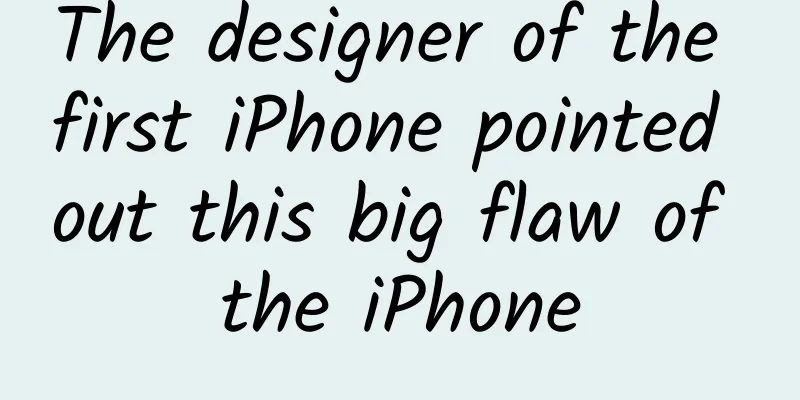The designer of the first iPhone pointed out this big flaw of the iPhone

|
As Apple's fall conference draws closer, leaks about the iPhone are starting to explode. Last night and this morning, Bloomberg, Ming-Chi Kuo and other institutions and individuals gave a series of leaks about the new iPhone. Will the features you care about most appear? Ming-Chi Kuo's ultimate prediction for this year's three new iPhones However, this article will not talk about the news of the new iPhone, but will talk about the design flaws of the iPhone. Recently, Imran Chaudhri, Apple's former user interface design director, talked about his views on iPhone design in an interview with Fast Company and pointed out what he thinks is the biggest flaw in iPhone design. Chaudhry joined Apple in 1995 and served as the design director of the human-computer interface group. He was also one of the six people in the first iPhone design team and laid the foundation for the iPhone's UI design style. So what does he think is the biggest design flaw of the iPhone? ▲The first generation iPhone design team. Image from: Twitter Chaudhry said that when he was testing the iPhone prototype, he knew that its biggest flaw was that it was too distracting and occupied the user's attention and time, and that Apple deliberately did not provide users with enough functions to maintain control of the device. Apple doesn't want to give users control of the iPhone? After the iPhone prototype was completed, Chaudhry was allowed to take it home to try it out. But soon Chaudhry began to be bombarded with phone calls all the time. Unable to bear the annoyance, Chaudhry decided to design a feature that could silence incoming calls when one did not want to be disturbed, which later became the "Do Not Disturb Mode". However, Chaudhry revealed that designing such a feature was not easy within Apple. When Chaudhry and others proposed giving more control back to users, they were always opposed by the marketing department: You can't do that because it would make the device uncool. Chaudhry also mentioned that the iPhone does have some tools that can help you be less addicted, "but it's not easy to know how to use them correctly. You need to spend a lot of time to understand what distracts you." Chaudhry said, "For those who really understand the phone, they can make good use of these features, but for those who are new to it, it's impossible." The book "The Secret History of the iPhone" also mentions that Jobs originally wanted to design two physical buttons on the iPhone, in addition to the Home button, there would also be a Back button, but Chaudhry believed that two physical buttons would increase the complexity of users controlling the phone. Chaudhry said that one of the flaws of smartphones on the market at that time was that many functions were hidden in the menu. Chaudhry's team even proposed a full-screen design without any physical buttons, but in the end they could only convince Jobs to retain a physical Home button. The Digital Wellbeing feature in iOS 12 may just be a PR exercise At the WWDC conference in June, Apple introduced "implicit push" for grouping notifications in iOS 12, "Screen Time" for managing the usage time of mobile phones and apps, and the "App Limits" function to set usage time limits for some apps. Chaudhry believes that this is not because Apple is truly aware of the problem of "mobile phone addiction", but rather a response under pressure in the face of accusations from numerous media outlets. Does this mean that users can get a better experience? No, this is just Apple's response to negative news. If they really realized the problem, they should have taken the initiative to promote these things. As I said before in "Anti-addiction is a scam announced in advance", technology companies launch anti-addiction features not to make you spend less time on their products, but more as a way to escape public criticism, more like a hypocritical act. An article in The Guardian describes it very aptly: Technology companies launching anti-addiction features is the same as giving away nicotine patches (for smoking cessation) when you buy cigarettes. However, Choudhry also expressed his understanding for his former employer, saying that product design in a large company is very complicated and often requires a balance between user experience and company interests. "The changes Apple has made are obviously not enough, but at least they have taken a step in the right direction." As the designer of the first iPhone, Chaudhry has a very "distant" relationship with the phone. He uses the black wallpaper of the first iPhone and has very few applications installed. Chaudhry believes that "digital health" should be the focus of future mobile phone design. Chaudhry left Apple in 2017 to start his own company. The designer, who participated in the development of products such as iPod, iPhone, iPad, Mac, and Apple Watch, has now begun to reflect on these popular products, which is a bit like "Einstein regretting making the atomic bomb." But obviously, Chaudhry's vision is unlikely to be realized in the short term, and "anti-addiction" still depends on your self-control. In other words, what do you think is the biggest flaw of the iPhone? |
<<: Android Butterknife (Butter Knife) Usage Summary
>>: From payment, purchase to after-sales service: Google Play Shopping Guide
Recommend
The 400 phone ringback tone has been activated. What is the phone number for activating the ringback tone?
Although 400 telephones are widely used, there ar...
Cook plans to retire? He told the media that he will try his best to train a successor
[[207470]] NetEase Technology News, October 25, a...
2022 Metaverse Marketing Myth
The metaverse can be generally understood as a vi...
WeChat has released a major new feature: WeChat Circle Experience
WeChat is no longer just an IM. Since WeChat 4.X,...
iOS 15 will focus on optimizing the notification center and lock screen interface
Bloomberg reported that iOS 15, which will be rel...
Case | Tiffany, Starbucks, and Durex use Christmas marketing to their advantage
The holidays are a special time of the year that ...
How did Uber become so popular? Let’s take a look at Uber’s marketing and branding strategy!
Uber is not just a means of transporting passenge...
How to apply for Shanxi Health Code? Shanxi Health Code application and usage instructions tutorial!
How to apply for Shanxi Health Code? Shanxi Healt...
What is Google overseas promotion and what are the advantages of Google promotion?
Google promotion, in layman's terms, is to us...
How to implement the real-name system at construction sites in Zhongshan City and what is the solution?
Judging from the current status of real-name mana...
"Dangal!" How to make Dad a hit through word of mouth? We have summarized 4 key techniques
" Dangal!" " Dangal " is the ...
Introduction to the process of 4 common marketing promotion methods
Previously we talked about some core work ideas o...
How to improve APP’s next-day retention?
What is next-day retention? Next-day retention, o...
Huawei's new patent is public: It can avoid being attacked by malicious QR codes
[[409110]] Scanning a QR code seems convenient, b...
Event promotion method: 4 steps to design an event to attract new customers using old customers!
Nowadays, it is becoming more and more expensive ...









